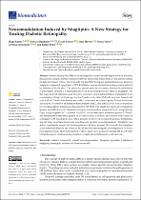| dc.contributor | Vall d'Hebron Barcelona Hospital Campus |
| dc.contributor.author | Ramos Abellan, Hugo |
| dc.contributor.author | Bogdanov Baruj, Patricia |
| dc.contributor.author | Sabater Martínez, David |
| dc.contributor.author | Huerta Alonso, Jordi |
| dc.contributor.author | Valeri Sala, Marta |
| dc.contributor.author | Hernández Pascual, Cristina |
| dc.contributor.author | Simó Canonge, Rafael |
| dc.date.accessioned | 2022-06-16T06:52:10Z |
| dc.date.available | 2022-06-16T06:52:10Z |
| dc.date.issued | 2021-11-26 |
| dc.identifier.citation | Ramos H, Bogdanov P, Sabater D, Huerta J, Valeri M, Hernández C, et al. Neuromodulation Induced by Sitagliptin: A New Strategy for Treating Diabetic Retinopathy. Biomedicines. 2021 Nov 26;9(12):1772. |
| dc.identifier.issn | 2227-9059 |
| dc.identifier.uri | https://hdl.handle.net/11351/7697 |
| dc.description | Proteínas presinápticas; Neurodegeneración retiniana; Sitagliptina |
| dc.language.iso | eng |
| dc.publisher | MDPI |
| dc.relation.ispartofseries | Biomedicines;9(12) |
| dc.rights | Attribution 4.0 International |
| dc.rights.uri | http://creativecommons.org/licenses/by/4.0/ |
| dc.source | Scientia |
| dc.subject | Retinopatia diabètica - Tractament |
| dc.subject | Peptidases - Inhibidors |
| dc.subject.mesh | Diabetic Retinopathy |
| dc.subject.mesh | /drug therapy |
| dc.subject.mesh | Dipeptidyl-Peptidase IV Inhibitors |
| dc.subject.mesh | /therapeutic use |
| dc.title | Neuromodulation Induced by Sitagliptin: A New Strategy for Treating Diabetic Retinopathy |
| dc.type | info:eu-repo/semantics/article |
| dc.identifier.doi | 10.3390/biomedicines9121772 |
| dc.subject.decs | retinopatía diabética |
| dc.subject.decs | /farmacoterapia |
| dc.subject.decs | inhibidores de la dipeptidil-peptidasa IV |
| dc.subject.decs | /uso terapéutico |
| dc.relation.publishversion | https://doi.org/10.3390/biomedicines9121772 |
| dc.type.version | info:eu-repo/semantics/publishedVersion |
| dc.audience | Professionals |
| dc.contributor.organismes | Institut Català de la Salut |
| dc.contributor.authoraffiliation | [Ramos H, Bogdanov P, Hernández C, Simó R] Unitat de Recerca en Diabetis i Metabolisme, Vall d’Hebron Institut de Recerca (VHIR), Barcelona, Spain. Universitat Autònoma de Barcelona, Bellaterra, Spain. Centro de Investigación Biomédica en Red de Diabetes y Enfermedades Metabólicas Asociadas (CIBERDEM), Instituto de Salud Carlos III (ICSIII), Madrid, Spain. [Sabater D, Huerta J] Unitat de Recerca en Diabetis i Metabolisme, Vall d’Hebron Institut de Recerca (VHIR), Barcelona, Spain. Universitat Autònoma de Barcelona, Bellaterra, Spain. [Valeri M] Unitat d'Alta Tecnologia, Vall d’Hebron Institut de Recerca (VHIR), Barcelona, Spain |
| dc.identifier.pmid | 34944588 |
| dc.identifier.wos | 000735987000001 |
| dc.relation.projectid | info:eu-repo/grantAgreement/ES/PE2017-2020/PID2019-104225RB-I00 |
| dc.relation.projectid | info:eu-repo/grantAgreement/ES/PE2013-2016/DTS18%2F00163 |
| dc.relation.projectid | info:eu-repo/grantAgreement/ES/PE2017-2020/PI19%2F01215 |
| dc.relation.projectid | info:eu-repo/grantAgreement/ES/PE2017-2020/ICI20%2F00129 |
| dc.rights.accessrights | info:eu-repo/semantics/openAccess |

 Área privada
Área privada Contacto
Contacto







